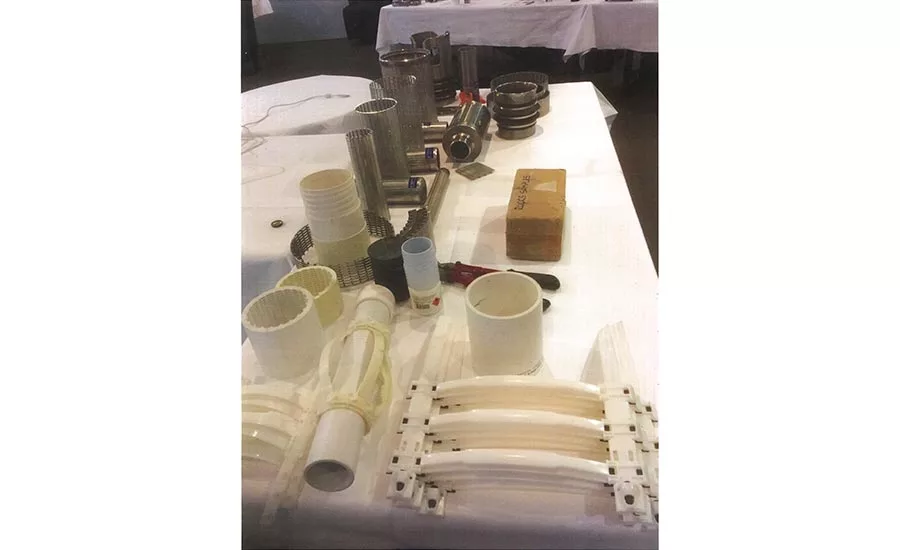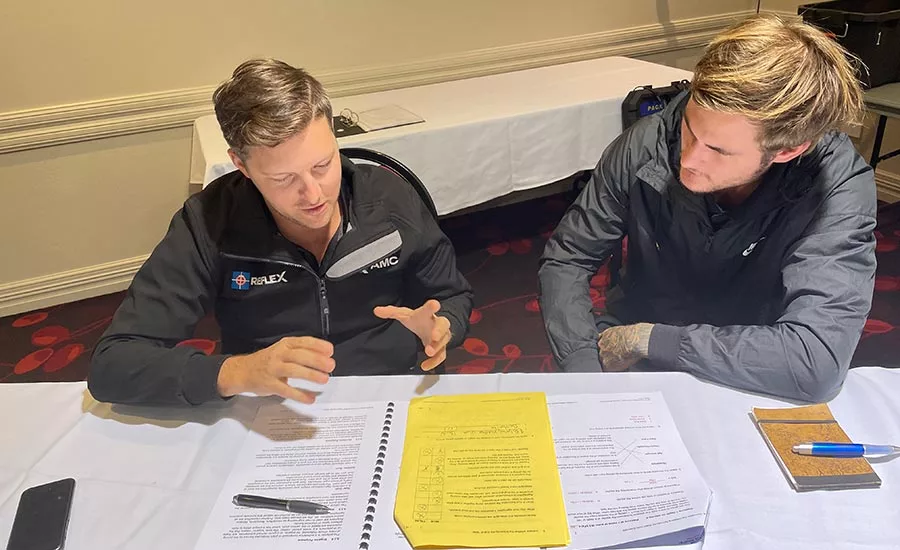An Australian Perspective on Drilling and Educating Drillers
Trainer Colin Barden Talks Training, 50 Years in the Drilling Industry

Colin Barden, right, director of Intertech Management based near Sydney, Australia, recently finished a round of training with the Australian Drilling Industry Association.
Source: Colin Barden

Colin Barden’s tools of the drill training trade, laid out for a recent training.
Source: Colin Barden

Barden says a lot of the drillers he trains work in minerals. Australia is a major producer of both gold and uranium.
Source: Colin Barden
As far as trainers go, Colin Barden has a resume as long as a drill string. His work goes back 50 years, and includes water well, mining, geotechnical and environmental. He has served in roles ranging from sales and service to product design and, yes, drilling. Now semi-retired, he still trains new and veteran drillers with the Australian Drilling Industry Association (ADIA) in his role as director of Intertech Management based near Sydney, Australia.
“My passion is, really, drilling holes in the ground and training people accordingly,” Barden says.
He has worked in the United States, the Middle East and Australia, where he says drillers do a lot of exploration work for uranium and gold. He recently wrapped up training sessions on screens and gravel packs, and mud testing and techniques.
“Once you get people actually involved in the industry, it’s not hard to keep them involved.”
We had Barden on our Drilling In-Site video and podcast series to talk training and drilling in Australia. This is an edited summary of our talk. Click here to see the full video, or here to listen to the podcast.
Q. Talk to us about your current role. You’ve stepped back into semi-retirement, but still train drillers. Why hang on to the training aspect?
A. My current role is a combination of many things because I’m semi-retired. I run training courses, face-to-face training courses, for the Australian Drilling Industry Association. … I keep abreast of what’s going on in the industry all the time through the training, and so forth. I do editing work on various different training manuals that we’ve got and, because of my background as CEO of the Australian Drilling Industry training committee, where I was for 10 years, I still do a fair bit of work with editing and new courses and new manuals and new procedures.
My passion is, really, drilling holes in the ground and training people accordingly. We’re involved pretty well down here in mineral exploration, because today we’re the number two gold producer in the world. China is number one. In America, in Fort Knox, you hold more gold than anybody else in the world, as in storage. But production-wise, we’re the number two producer. We’re also the number one producer of uranium. So there’s a lot of exploration work going on, and it’s picked up tremendously in the last 12 months. I would think that at least 60 to 70% of our drill rigs would be working on mineral exploration work — of all types of minerals.
That allows the training to come in, because Australia as a country is probably, landmass-wise, about the same size — maybe a little bit less, but not much — as the continental United States, with only 25 million people. If you compare the difference in population to what you have, the vast traveling distances that we’ve got, most people live on the East Coast of Australia because, basically, most of the minerals are always where you don’t want to go. If drilling for minerals ESA in Sydney was applicable and you could do it from an environmental perspective, everybody would want to do it. That’s the thing. Probably one of your questions are going to be about people entering the industry. We’ve got many people these days who want to go to university to start with. The moment they go to university then, naturally enough, they don’t want to go out to the middle of the nowhere to drill holes in the ground. So it’s one of those things. It’s always hard to get people.
Once you get people actually involved in the industry, it’s not hard to keep them involved unless there’s a downturn. I’ve never seen too many people leave this industry, with the exception of a downturn in it. We have the mineral exploration. We’ve also got water wells, of which they’re quite diversified, and geotechnical and environmental work. The geotech and environmental work, naturally enough, is in the cities more so than anywhere else. The water wells are a combination of both, because you’re either in city or outside in residential blocks, or on the larger farms — or ranches you’d like to call them.
But, other than that, yeah, I keep myself fairly well involved, which I like to do because it’s one of those things. I quite believe the fact that, if you stop being involved in the industry that you’ve actually worked in all your life, and go off and run and do something altogether stupid differently, it doesn’t take long before you get sick of it. I still love the industry.
Q. You’ve worked and trained all over the world. What are some of the differences between drilling in the United States versus Australia?
A. That’s a difficult one, because when I first went to the States and I was employed as a special representative with the company Gardner-Denver in Dallas, Texas, people were asking the question, “What are you doing here in Texas teaching us how to drill holes?” Or [a similar question] from the manufacturing point of view. The same thing applies a little bit over here. However, we work with each other and learn a tremendous amount. A good example is reverse circulation drilling — as in air core and stuff like that, which is RC. It was invented here and that’s been transferred across to America, and it’s been quite successful for mineral drilling. There’s a lot of things that cross pollinate from what has been learned over the years and years and years of experience. Those new ideas get sent across between ourselves, our two different countries, quite often. … I would think [we’re in] the two [most] experienced countries in the world of drilling, America and Australia, without a doubt. We’re sharing that knowledge constantly with each other, all the time.
I think also, particularly with our various different associations and the organization that you work for, that cross-pollination of ideas all the time is extremely good. Everybody comes out of it with a good learning curve. The difference [between the two countries] is probably more to do with distance of traveling here, accent, slowing down the speech. We have a tendency to clip our words a lot and sometimes are a little hard to understand, and particularly when we use slang language.
I like to work in America very much. If I had a choice to go somewhere else other than live in Australia, I would most certainly go live in America tomorrow, not a problem — and not only that, but be well received. I think that’s one of the most important things: The hospitality that we, as Australians, have received in America has been phenomenal. Always, always the same, always fantastic hospitality and it’s well received. We try to do the same thing here. Our problem happens to be the many, many, many miles or kilometers of distance for mobilization of drill rigs and so forth. It can take three or four days just to mobilize to one site. Other than that, I don’t see too much differences. There might be a little bit of difference in geology, but I think, you know, you get some people that say our geology is different. “Oh, yeah? Right. Tell us another one.” [chuckles] There’s always difficult ground to drill — always —and there’s always good ground to drill. Everybody loves to find the nice happy medium.
Q. What trait do you hope to see in folks entering the drilling field? Maybe I’m pretty good in shop class and intrigued by the industry, but don’t have training. What do I need to do to get up to speed, come into this industry and be welcome?
A. The most important thing is to be keen, want to work, want to learn and show the interest that you want to get ahead. Now, irrespective of where you’ve been, if you can show that mentality and that you’re willing to learn, lots of drilling contractors will give you a start.
I think, with the amount of training that we put into people in this industry, you want to make sure that you’re getting an average percentage of the right people in to start with. You can spend a lot of time and money training somebody, and it doesn’t work out. That’s sad for everybody — not only the employee, but the employer, the costs associated and everything. So I would think most important … happens to be commitment and the willingness to learn. That’s probably the same with every job, but it’s probably more so in this drilling industry, I believe.
The Full Interview
We interviewed Colin Barden for episode 25 of our Drilling In-Site series. In addition to these questions, our talk covered the age gap in trades, Australia’s high safety standards and other topics. See the full conversation at www.thedriller.com/insite, or listen to the podcast version at www.thedriller.com/insite-podcast. Episodes also in Apple’s Podcast store. Search Drilling In-Site and tap Subscribe.
Working on an interesting project or have industry wisdom to share? Email verduscoj@bnpmedia.com to be considered for a guest spot on Drilling In-Site.
Looking for a reprint of this article?
From high-res PDFs to custom plaques, order your copy today!









